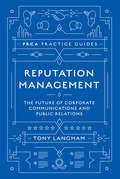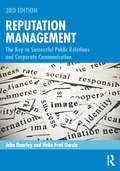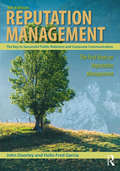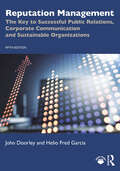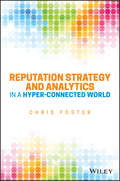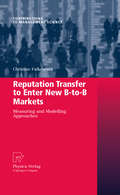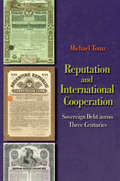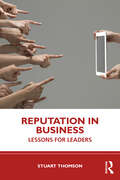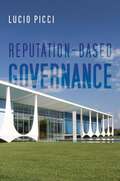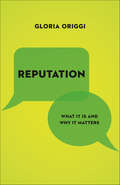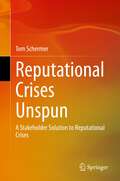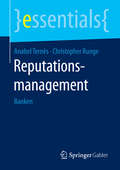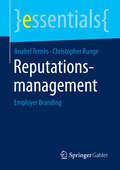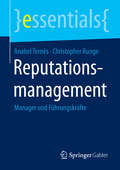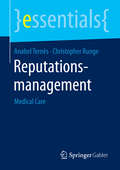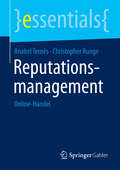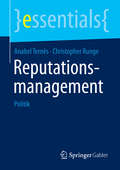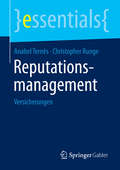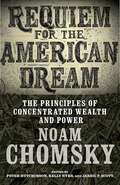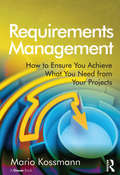- Table View
- List View
Reputation Management: The Future Of Corporate Communications and Public Relations (PRCA Practice Guides)
by Tony Langham PrcaA good reputation is vital to success in business and in life. Organizations with the best reputations outperform rivals in a myriad of tangible ways; they recruit higher quality staff, succeed with smaller marketing budgets, and exert greater influence over Governments. Although in the long term reputation is based on reality and behavior, short term examples of organizations and individuals building unfair advantage can be seen all around us. Despite this, reputation remains an often misunderstood and neglected asset. <p><p>In Reputation Management: The Future of Corporate Communications and Public Relations, Tony Langham argues that reputation management is the future incarnation of public relations and corporate communications. Featuring specially commissioned essays, as well as exclusive interviews with leading CEOs, influencers and celebrities, the book covers issues as diverse as fake news, AI, James Bond, cyber security and internet bullying. Also included are contributions from thirty-nine of the world’s leading reputation managers who exclusively reveal the time they made the most difference to an organization's reputation.
Reputation Management: The Key to Successful Public Relations and Corporate Communication
by John Doorley Helio Fred GarciaReputation Management is a how-to guide for students and professionals, as well as CEOs and other business leaders. It rests on the premise that reputation can be measured, monitored, and managed. Organized by corporate communication units including media relations, employee communication, government relations, and investor relations, the book provides a field-tested guide to corporate reputation problems such as leaked memos, unfair treatment by the press, and negative rumors, and focuses on practical solutions. Each chapter is fleshed out with the real-world experience of the authors and contributors, who come from a wide range of professional corporate communication backgrounds. Updates to the third edition include: Global content has been incorporated and expanded throughout the book, rather than being restricted to only one chapter. Opening vignettes, examples, and case studies have been updated in each chapter. Additional case studies and examples with an international focus have been added.
Reputation Management: The Key to Successful Public Relations and Corporate Communication
by John Doorley Helio Fred GarciaReputation Management is an established how-to guide for students and professionals, as well as CEOs and other business leaders. This fourth edition is updated throughout, including: new social media management techniques for the evolving age of digital media, and perspectives on reputation management in an era of globalization. The book is embroidered by ethics, and organized by corporate communication units, such as media relations, issues management, crisis communication, organizational communication, government relations, and investor relations. Each chapter is fleshed out with the real-world experiences cited by the authors and contributions from 36 leaders in the field, including The Arthur W. Page Society, the International Communications Consultancy Organization, the PR Council, CVS Health, Edelman and Ketchum. This was the first book on reputation management and, now in its fourth edition, remains a must-have reference for students taking classes in public relations management, corporate communication, communication management, and business. CEOs, business leaders, and professionals working in these areas find it a reliable resource for measuring, monitoring and managing reputation.
Reputation Management: The Key to Successful Public Relations, Corporate Communication and Sustainable Organizations
by John Doorley Helio Fred GarciaThe fifth edition of this classic text, which was the first on the subject of reputation management, gives readers the guidance and skills needed to manage brand and reputation through effective performance, behavior, identity and communication strategies.This edition is updated throughout, including current information on digital media, new global examples and a renewed emphasis on organizational and environmental sustainability. Each chapter again features timely and illustrative cases by the authors and contributions from leaders in the field, with new cases in this edition on such topics as COVID-19, artificial intelligence, and generative AI. Additionally, the book maintains its consistent throughline focusing on corporate ethics.This fifth edition is a must-have reference for students taking classes in public relations management, corporate communication, communication management and business. CEOs, business leaders and professionals working in these areas find it a reliable resource for measuring, monitoring and managing reputation.Online resources also accompany the text. Please visit www.routledge.com/9781032577999.
Reputation Strategy and Analytics in a Hyper-Connected World
by Chris FosterReputation management techniques that work amidst the unceasing flow of information Reputation Strategy and Analytics in a Hyper-Connected World is a complete guide to corporate communications and reputation management. Covering a range of scenarios from ideal to catastrophic, this book provides a clear blueprint for preparation, execution, and beyond. The discussion focuses on data-driven, evidence-based strategies for the modern digital economy, providing actionable frameworks, practical roadmaps, and step-by-step blueprints for deploying advance analytics, predictive modeling, and big data techniques to successfully manage communications and reputation. You'll learn how the right tools and people get the job done quickly, effectively, and cost-effectively, and how to identify and acquire the ones you need. Coverage includes the latest technology and cutting-edge applications, bringing you up to speed on what excellence in communications can realistically be. We live in an age of interconnectedness and transparency, and information travels at the speed of light to reach nearly every corner of the globe. This book shows you the key strategies and operational tactics required to respond successfully to financially damaging assaults on your company's reputation. Execute world-class corporate communications Prepare for best- and worst-possible case scenarios Manage organizational reputation in the digital economy Pick the right team and the right tools to get the job done Stories, rumors, lies -- there is no safe haven. Big data, cloud, and mobile technologies are fueling a perfect storm of immense proportions, overwhelming the capabilities of organizations and individuals attempting to manage their brands and reputations when hit with damaging information or harmful stories. Reputation Strategy and Analytics in a Hyper-Connected World shows you navigate the never-ending information stream to keep your company out of the undertow.
Reputation Transfer to Enter New B-to-B Markets
by Christine FalkenreckThis book focuses on the development and cross-cultural testing of a construct of reputation rooted in resource-based theories. No study has ever asked organizational customers to rate the importance of a supplier's positive reputation on their buying decision. The results of the survey contribute substantially to our understanding of reputation measuring and managing. This book is the first to highlight the cross-link between reputation, reputation transfer and culture, and argues that to develop one cross-culturally valid construct of reputation, which can be used in both B-to-B and B-to-C contexts is neither useful nor appropriate.
Reputation and International Cooperation: Sovereign Debt across Three Centuries
by Michael TomzHow does cooperation emerge in a condition of international anarchy? Michael Tomz sheds new light on this fundamental question through a study of international debt across three centuries. Tomz develops a reputational theory of cooperation between sovereign governments and foreign investors. He explains how governments acquire reputations in the eyes of investors, and argues that concerns about reputation sustain international lending and repayment. Tomz's theory generates novel predictions about the dynamics of cooperation: how investors treat first-time borrowers, how access to credit evolves as debtors become more seasoned, and how countries ascend and descend the reputational ladder by acting contrary to investors' expectations. Tomz systematically tests his theory and the leading alternatives across three centuries of financial history. His remarkable data, gathered from archives in nine countries, cover all sovereign borrowers. He deftly combines statistical methods, case studies, and content analysis to scrutinize theories from as many angles as possible. Tomz finds strong support for his reputational theory while challenging prevailing views about sovereign debt. His pathbreaking study shows that, across the centuries, reputations have guided lending and repayment in consistent ways. Moreover, Tomz uncovers surprisingly little evidence of punitive enforcement strategies. Creditors have not compelled borrowers to repay by threatening military retaliation, imposing trade sanctions, or colluding to deprive defaulters of future loans. He concludes by highlighting the implications of his reputational logic for areas beyond sovereign debt, further advancing our understanding of the puzzle of cooperation under anarchy.
Reputation in Business: Lessons for Leaders
by Stuart ThomsonA compelling mix of reputation management, crisis leadership and the role of politics in business, this book provides unique practical steps that leaders can take to protect their reputations and those of the organisations they head in an ever more open social media-led world. Although leaders increasingly recognise the vital intangible asset that reputation represents, too many do not really understand what reputation is and the steps that should be taken to build it and their corporate value. Given the range of factors depending on the organisation, each aspect of its complex reputational story needs to be unpicked if a reputation is to be built, maintained and protected. This step by-step-guide offers advice on how to develop the strategies needed to do this, provides clear lessons throughout from a range of experts - and distinctively, looks beyond the corporate sector to charities, governments, NGOs and the public sector. Boards, trustees, non-executive directors, senior management, and leaders of all types of organisations need to consider the steps that should be taken to build, maintain and defend their reputation, and that means knowing what their reputation is and the audiences that matter most to them. This book is the roadmap.
Reputation-Based Governance
by Lucio PicciIt would be easy to cheat someone on eBay. However, an essential characteristic of the site prevents this from happening: buyer and seller reviews form what amounts to an "index of reputation. " The availability of such an index provides a strong incentive to be an honest trader. Reputation-Based Governance melds concepts from businesses like eBay with politics. Author Lucio Picci uses interdisciplinary tools to argue that the intelligent use of widely available Internet technologies can strengthen reputational mechanisms and significantly improve public governance. Based on this notion, the book proposes a governance model that leans on the concept of reputational incentives while discussing the pivotal role of reputation in politics today. Picci argues that a continuous, distributed process of assessing policy outcomes, enabled by an appropriate information system, would contribute to a governance model characterized by effectiveness, efficiency, and a minimum amount of rent-seeking activity. Moreover, if citizens were also allowed to express their views on prospective policies, then reputation-based governance would provide a platform on which to develop advanced forms of participative democracy.
Reputation: What It Is and Why It Matters
by Gloria OriggiA compelling exploration of how reputation affects every aspect of contemporary lifeReputation touches almost everything, guiding our behavior and choices in countless ways. But it is also shrouded in mystery. Why is it so powerful when the criteria by which people and things are defined as good or bad often appear to be arbitrary? Why do we care so much about how others see us that we may even do irrational and harmful things to try to influence their opinion? In this engaging book, Gloria Origgi draws on philosophy, social psychology, sociology, economics, literature, and history to offer an illuminating account of an important yet oddly neglected subject.Origgi examines the influence of the Internet and social media, as well as the countless ranking systems that characterize modern society and contribute to the creation of formal and informal reputations in our social relations, in business, in politics, in academia, and even in wine. She highlights the importance of reputation to the effective functioning of the economy and e-commerce. Origgi also discusses the existential significance of our obsession with reputation, concluding that an awareness of the relationship between our reputation and our actions empowers us to better understand who we are and why we do what we do.Compellingly written and filled with surprising insights, Reputation pins down an elusive subject that affects everyone.
Reputational Crises Unspun: A Stakeholder Solution to Reputational Crises
by Tom SchermerThis book reviews dominant crisis communication theories, which according to many scholars are either too narrow or broad for practical application to all types of reputational crises. Freeman, as the progenitor of modern stakeholder theory, has spent much time since the original publication trying to remove the primary focus from companies to that of achieving broader positive outcomes for organisations, populations, and the operating environment. This book embraces the ethos of Freeman’s revisions and applies it to crisis communication through placing the reputational crisis at the centre of a stakeholder map, where other literature places the company at the centre of the stakeholder map. This leaves the company experiencing the crisis situated with all other crisis stakeholders to develop solutions to the source of conflict, and as a result, the reputational crisis.Removing the corporation from the centre allows for other stakeholders such as interest groups, politicians, media, and afflicted stakeholders, to legitimately work towards solving the crisis. This book uses a typology of apologia and builds upon it to create a means that allows corporate managers to genuinely apologise to crisis victims, without necessarily exposing the corporation to financial liability claims. The apologia construct developed herein is equally useful to CEO’s as it is in a domestic situation.Consistent throughout this book is the philosophy that all reputational crises can be either solved, or significantly reduced in terms of impact. Examples used throughout relate to reader’s personal lives as well as structured powerful organisations.
Reputationsmanagement: Banken (essentials)
by Anabel Ternès Christopher RungeAnabel Ternès und Christopher Runge zeigen am Beispiel Banken, dass es sich auszahlt, in eine hohe Reputation zu investieren. Unternehmen mit einem guten Ansehen können höhere Preise verlangen, Kunden gewinnen und binden, die besten Mitarbeiter für sich gewinnen und insbesondere in Krisenzeiten von ihrer Reputation als immateriellem Wert als Wettbewerbsvorteil zehren. Voraussetzung hierfür ist ein systematisches, professionell begleitetes Reputationsmanagement, das gewährleistet, in Zukunft zu agieren statt nur zu reagieren. Gutes Reputationsmanagement erfordert einzelne, aufeinander abgestimmte Schritte, die sich gegenseitig perfekt ergänzen – zum Aufbau, zum Erhalt und zur Verbesserung einer positiven Unternehmensreputation.
Reputationsmanagement: Employer Branding (essentials)
by Anabel Ternès Christopher RungeAnabel Ternès und Christopher Runge zeigen am Beispiel des ,,War for Talents" um die bestqualifizierten Mitarbeiter, dass es sich auszahlt, in eine hohe Reputation zu investieren. Ziel des Reputationsmanagements muss es daher sein, sich gegenüber Mitarbeitern und potenziellen Bewerbern als attraktiver Arbeitgeber zu präsentieren und so aktiv gute Mitarbeiter zu binden sowie neue Talente zu gewinnen. Dazu muss das Bedürfnis dieser Talente nach einem für sie optimalen Arbeitsplatz gezielt angesprochen werden, weshalb es des Aufbaus des Unternehmens als Arbeitgebermarke und vor allem der umsichtigen und zukunftsorientierten Pflege dieser Marke bedarf.
Reputationsmanagement: Manager und Führungskräfte (essentials)
by Anabel Ternès Christopher RungeAnabel Ternès und Christopher Runge zeigen am Beispiel von Managern und Führungskräften, dass es sich auszahlt, in eine hohe Reputation zu investieren. Binnen Sekunden verbreiten sich schlechte Nachrichten und Bewertungen über soziale Netzwerke und Internetforen. Eine negative Information entwickelt auf diese Weise schnell ein unkontrollierbares Eigenleben – mit unabsehbaren Folgen. Gerade für Manager und Führungskräfte ist es wichtig, stets den Überblick zu haben, was „das Netz“ über die eigene Person oder das eigene Unternehmen sagt. Eine schlechte Reputation kann nicht nur zu Umsatzeinbußen führen, sondern den guten Ruf nachhaltig schädigen. Wichtig ist daher, proaktiv vorzubauen, um den guten Ruf im Netz zu schützen.
Reputationsmanagement: Medical Care (essentials)
by Anabel Ternès Christopher RungeAnabel Ternès und Christopher Runge zeigen am Beispiel Banken, dass es sich auszahlt, in eine hohe Reputation zu investieren. Unternehmen mit einem guten Ansehen können höhere Preise verlangen, Kunden gewinnen und binden, die besten Mitarbeiter für sich gewinnen und insbesondere in Krisenzeiten von ihrer Reputation als immateriellem Wert als Wettbewerbsvorteil zehren. Voraussetzung hierfür ist ein systematisches, professionell begleitetes Reputationsmanagement, das gewährleistet, in Zukunft zu agieren statt nur zu reagieren. Gutes Reputationsmanagement erfordert einzelne, aufeinander abgestimmte Schritte, die sich gegenseitig perfekt ergänzen - zum Aufbau, zum Erhalt und zur Verbesserung einer positiven Unternehmensreputation.
Reputationsmanagement: Online-Handel (essentials)
by Anabel Ternès Christopher RungeAnabel Ternès und Christopher Runge zeigen am Beispiel des Online-Handels, dass es sich auszahlt, in eine hohe Reputation zu investieren. Räumliche Grenzen existieren in Zeiten von Social Media nicht mehr. Binnen Sekunden verbreiten sich schlechte Nachrichten und Bewertungen über soziale Netzwerke und Internetforen – ob sie nun der Wahrheit entsprechen oder nicht. Eine negative Information entwickelt auf diese Weise schnell ein unkontrollierbares Eigenleben – mit unabsehbaren Folgen. Gerade im Online-Handel ist es wichtig, stets den Überblick zu behalten, was „das Netz“ über das eigene Unternehmen sagt. Negative Kundenbewertungen und schlechte Presse können zu Umsatzeinbußen führen und den Ruf nachhaltig schädigen. Wichtig ist daher, proaktiv vorzubauen, um den guten Ruf im Netz zu schützen – mit einem professionellen Partner an der Seite, der strategisch vorausplant.
Reputationsmanagement: Politik (essentials)
by Anabel Ternès Christopher RungeAnabel Ternès und Christopher Runge zeigen am Beispiel Politik, dass es sich auszahlt, in eine hohe Reputation zu investieren. Gerade wer ein politisches Amt bekleidet, steht besonders im Fokus der öffentlichen Aufmerksamkeit. Jede Geste, jedes Wort kann von sozialen Netzwerken und Online-Medien aufgegriffen und in Windeseile verbreitet werden. Klassische Medien wie Tageszeitungen, Magazine und auch TV-Sendungen verbreiten die Nachricht zusätzlich weiter, und im Nu ist ein Skandal entstanden, dessen Folgen unabsehbar sind und oftmals das Ende der Karriere bedeuten. Wichtig ist daher, proaktiv vorzubauen, um den guten Ruf im Netz zu schützen – mit einem professionellen Partner an der Seite.
Reputationsmanagement: Versicherungen (essentials)
by Anabel Ternès Christopher RungeAnabel Ternès und Christopher Runge zeigen am Beispiel Versicherungen, dass es sich auszahlt, in eine hohe Reputation zu investieren. Unternehmen mit einem guten Ansehen können höhere Preise verlangen, Kunden gewinnen und binden, die besten Mitarbeiter für sich gewinnen und insbesondere in Krisenzeiten von ihrer Reputation als immateriellem Wert als Wettbewerbsvorteil zehren. Voraussetzung hierfür ist ein systematisches, professionell begleitetes Reputationsmanagement, das gewährleistet, in Zukunft zu agieren statt nur zu reagieren. Gutes Reputationsmanagement erfordert einzelne, aufeinander abgestimmte Schritte, die sich gegenseitig perfekt ergänzen – zum Aufbau, zum Erhalt und zur Verbesserung einer positiven Unternehmensreputation.
Requiem for New Orleans
by Leon Sharpe"Requiem for New Orleans" is a lament for the destruction of a great city and scorn for those who allowed it to happen. Mike Sharpe writes: "New Orleans was not destroyed by a hurricane but by abandonment." Above all, "Requiem for New Orleans" is a meditation on our ability to overcome loss. It is an interweaving of biblical cadences, black idiom, standard American speech, jazz, and the caustic side of protest music. The author leaves us with a question: when will we learn what we must from the fate of New Orleans?
Requiem for the American Dream: The 10 Principles of Concentration of Wealth & Power
by Noam Chomsky Jared P. Scott Kelly Nyks Peter Hutchison<P>In his first major book on the subject of income inequality, Noam Chomsky skewers the fundamental tenets of neoliberalism and casts a clear, cold, patient eye on the economic facts of life. <P>What are the ten principles of concentration of wealth and power at work in America today? They're simple enough: reduce democracy, shape ideology, redesign the economy, shift the burden onto the poor and middle classes, attack the solidarity of the people, let special interests run the regulators, engineer election results, use fear and the power of the state to keep the rabble in line, manufacture consent, marginalize the population. <P>In Requiem for the American Dream, Chomsky devotes a chapter to each of these ten principles, and adds readings from some of the core texts that have influenced his thinking to bolster his argument. <P>To create Requiem for the American Dream, Chomsky and his editors, the filmmakers Peter Hutchison, Kelly Nyks, and Jared P. Scott, spent countless hours together over the course of five years, from 2011 to 2016. After the release of the film version, Chomsky and the editors returned to the many hours of tape and transcript and created a document that included three times as much text as was used in the film. <P> The book that has resulted is nonetheless arguably the most succinct and tightly woven of Chomsky's long career, a beautiful vessel--including old-fashioned ligatures in the typeface--in which to carry Chomsky's bold and uncompromising vision, his perspective on the economic reality and its impact on our political and moral well-being as a nation. <P><b>A New York Times Bestseller</b>
Requiem for the American Dream: The Principles of Concentrated Wealth and Power
by Noam ChomskyA <i>NEW YORK TIMES</i> BESTSELLER!<p><p> In his first major book on the subject of income inequality, Noam Chomsky skewers the fundamental tenets of neoliberalism and casts a clear, cold, patient eye on the economic facts of life. What are the ten principles of concentration of wealth and power at work in America today? They're simple enough: reduce democracy, shape ideology, redesign the economy, shift the burden onto the poor and middle classes, attack the solidarity of the people, let special interests run the regulators, engineer election results, use fear and the power of the state to keep the rabble in line, manufacture consent, marginalize the population. In Requiem for the American Dream, Chomsky devotes a chapter to each of these ten principles, and adds readings from some of the core texts that have influenced his thinking to bolster his argument. <p> To create Requiem for the American Dream, Chomsky and his editors, the filmmakers Peter Hutchison, Kelly Nyks, and Jared P. Scott, spent countless hours together over the course of five years, from 2011 to 2016. After the release of the film version, Chomsky and the editors returned to the many hours of tape and transcript and created a document that included three times as much text as was used in the film. The book that has resulted is nonetheless arguably the most succinct and tightly woven of Chomsky's long career, a beautiful vessel--including old-fashioned ligatures in the typeface--in which to carry Chomsky's bold and uncompromising vision, his perspective on the economic reality and its impact on our political and moral well-being as a nation.<p> "During the Great Depression, which I'm old enough to remember, it was bad–much worse subjectively than today. But there was a sense that we'll get out of this somehow, an expectation that things were going to get better . . ." —from Requiem for the American Dream
Requirements Engineering for Social Sector Software Applications: Innovating for a Diverse Set of User Needs
by Varun GuptaThis book presents interdisciplinary research in software engineering with applications for the social sector. The author focuses on software applications that are used for social good and that serve the needs of society. The author aims to bridge the knowledge gap between requirement engineers, industry, and users in order to help identify a diverse range of needs in the social sector (taking into account user crowd diversity in terms of technological competencies, geography, demographics, and behavioral and psychographic aspects). The book provides rigorous empirical studies and validates solutions that serve as a guide to the software engineering community, researchers, graduate students, and teachers.Provides interdisciplinary research in software engineering and the needs of the social sector, helping to increase success rates of society focused startups and applicationsIdeal for social entrepreneurs who can use the book for doing customer development with diverse usersEstablishes a new research line of social sector requirement engineering, taking into account user age, language, ability, and access
Requirements Engineering für Softwareanwendungen im sozialen Sektor: Innovationen für eine Vielzahl von Nutzerbedürfnissen
by Varun GuptaDieses Buch stellt interdisziplinäre Forschung im Bereich Software-Engineering von Anwendungen für den sozialen Sektor vor. Der Autor konzentriert sich auf Softwareanwendungen, die für soziale Zwecke eingesetzt werden und den Bedürfnissen der Gesellschaft dienen. Der Autor möchte die Wissenslücke zwischen den Requirements Engineers, der Industrie und den Nutzern schließen, um dazu beizutragen, ein breites Spektrum an Bedürfnissen im sozialen Sektor zu identifizieren (unter Berücksichtigung der Vielfalt der Nutzergruppen in Bezug auf technologische Kompetenzen, Geografie, Demografie sowie verhaltensbezogene und psychografische Aspekte). Das Buch bietet rigorose empirische Studien und validierte Lösungen, die als Leitfaden für die Software-Engineering-Gemeinschaft sowie Forscher, Doktoranden und Lehrer dienen. - Bietet interdisziplinäre Forschung im Bereich Software-Engineering sowie den Bedürfnissen des sozialen Sektors und trägt dazu bei, die Erfolgsquote von auf die Gesellschaft ausgerichteten Startups und Anwendungen zu erhöhen- Ideal für soziale Unternehmer, um das Buch für die Kundenentwicklung mit verschiedenen Nutzern nutzen zu können - Etabliert eine neue Forschungslinie für die Entwicklung von Anforderungen im sozialen Sektor, die Alter, Sprache, Fähigkeiten und Zugang der Nutzer berücksichtigt.
Requirements Engineering: Laying a Firm Foundation
by James A. Crowder Curtis W. HoffThis textbook lays the foundations for System-of-Systems Requirements Engineering and Requirements Management practices, principles, technique, and processes. It provides a comprehensive treatment of requirements engineering, an integral part of Multidisciplinary Systems Engineering. The book takes the student/reader though the entire process of documenting, analyzing, tracing, prioritizing, and managing requirements, and then goes on the describe controlling and communicating requirement change throughout the system development lifecycle. The authors discuss the role of requirements management in support of other requirements engineering processes; describe the principal requirements engineering activities and their relationships; introduces techniques for requirements elicitation and analysis and describes requirements validation and the role of requirements reviews; and discusses the role of requirements management in support of other requirements engineering processes. A full suite of classroom material is provided including exercises, assignments, and PowerPoint slides.
Requirements Management: How to Ensure You Achieve What You Need from Your Projects
by Mario KossmannPoor requirements management is one of the top five contributors to poor project performance. In extreme, safety critical or emergency-relief situations, failure to satisfy the real needs of the project stakeholders may well lead directly to loss of life or human suffering; other, more mundane, projects can also be severely compromised. Dr Mario Kossmann’s Requirements Management looks at the process from the perspectives of both Program and Project Management and Systems Engineering, showing the crucial role of RM in both contexts. The author puts great emphasis on the human aspects of any project, which is also significant given that over-emphasis on technical or technological aspects at the expense of the human side is another major source of project shortfalls. The book offers illustrated examples of systems of different levels of complexity (one simple system, one complex, and one highly complex system) to help you categorize your own system and enable you to select the right level of formality, a suitable organization and a set of techniques and tools to carry out your requirements work. It includes a series of comprehensive checklists which can be used immediately to improve urgent requirements aspects. This is a practical and realistic guide to requirements management that provides a flexible, hands-on and innovative approach to developing and managing program, project and system requirements at different levels of complexity; read it and use the advice offered to ensure your projects can actually deliver, first time, without the need for costly and time-consuming rework.
